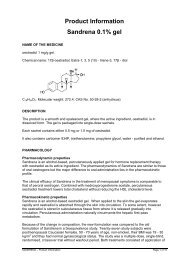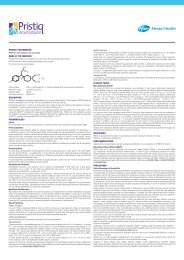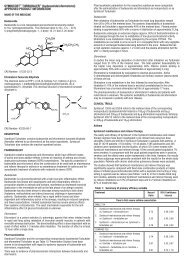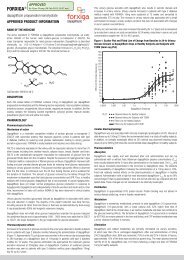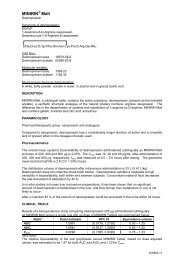Create successful ePaper yourself
Turn your PDF publications into a flip-book with our unique Google optimized e-Paper software.
transaminase elevations resulted in the discontinuation of 0.3% (82/27,229) ofCYMBALTA-treated patients. In these patients, the median time to detection of thetransaminase elevation was about two months. In placebo controlled trials in anyindication, elevations of alanine transaminase (ALT) to >3 times the upper limit ofnormal occurred in 1.1% (85/7632) of CYMBALTA-treated patients and in0.2% (13/5578) of placebo treated patients. In placebo-controlled studies using a fixeddose design, there was evidence of a dose-response relationship for ALT and ASTelevation of >3 times the upper limit of normal and >5 times the upper limit of normal,respectively.Postmarketing reports have described cases of hepatitis with abdominal pain,hepatomegaly and elevation of transaminase levels to more than twenty times the upperlimit of normal with or without jaundice, reflecting a mixed or hepatocellular pattern ofliver injury. Cases of cholestatic jaundice with minimal elevation of transaminase levelshave also been reported. Isolated cases of liver failure, including fatal cases, have beenreported. A majority of these cases have been reported in patients with past or currentrisk factors for liver injury, including alcohol abuse, hepatitis or exposure to drugs withknown adverse effects on the liver.The combination of transaminase elevations and elevated bilirubin, without evidence ofobstruction, is generally recognised as an important predictor of severe liver injury. Inclinical trials, 7 CYMBALTA patients had elevations of transaminases and bilirubin, but5 of 7 also had elevation of alkaline phosphatase, suggesting an obstructive process; inthese patients, in 3 of these 7 patients there was evidence of heavy alcohol use and thismay have contributed to the abnormalities seen.Postmarketing reports indicate that elevated transaminases, bilirubin and alkalinephosphatase have occurred in patients with chronic liver disease or cirrhosis.AlcoholBecause it is possible that duloxetine and alcohol may interact to cause liver injury or thatduloxetine may aggravate pre-existing liver disease, CYMBALTA should ordinarily notbe prescribed to patients with substantial alcohol use or evidence of chronic liver disease(see PRECAUTIONS – Hepatotoxicity)Bipolar DisorderA major depressive episode may be the initial presentation of bipolar disorder. It isgenerally believed that treating such an episode with an antidepressant alone can increasethe likelihood of precipitation of a mixed/manic episode in patients at risk of bipolardisorder. Prior to initiating treatment with an antidepressant, patients should beadequately screened to determine if they are at risk for bipolar disorder; such screeningshould include a detailed psychiatric history, including a family history of suicide, bipolardisorder, and depression.Cymbalta PI Nov 2012 v8.0 13



